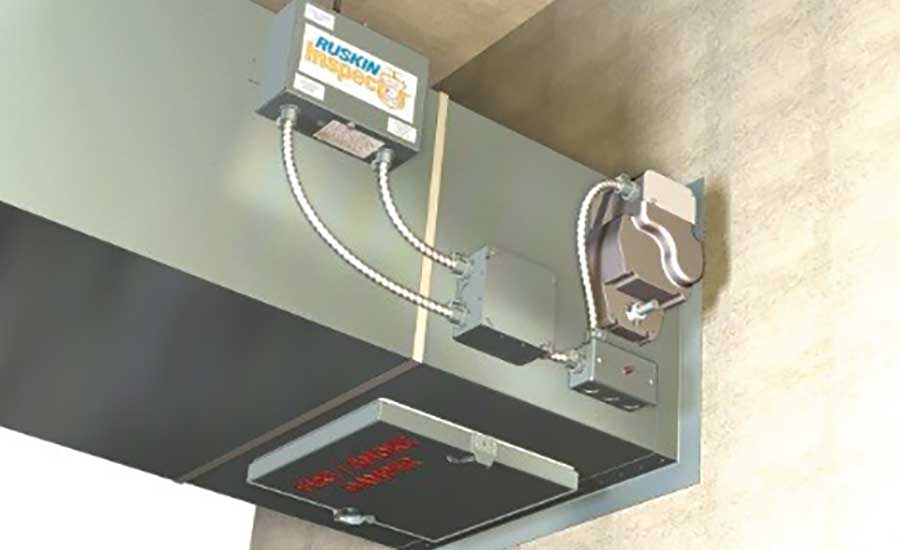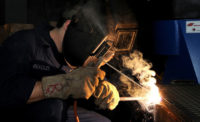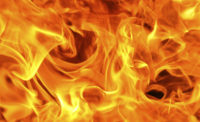A fire damper is a device installed in ducts and air transfer openings of an air distribution or smoke control system that is designed to close automatically upon detection of heat. In doing so, the damper interrupts migratory airflow, resists the passage of flame and maintains the integrity of the fire-rated separation.
The significant protection capabilities of fire dampers to life and property are widely recognized by facility managers. As a result, more and more authorities having jurisdiction (AHJs) and building owners are requiring fire dampers to be operationally tested and maintained on a regular basis. The goal is to ensure that dampers will function when necessary to resist the spread of fire.
Multiple standards define testing requirements
All dampers must be tested after installation, and then one year after installation or at the commissioning under normal operating conditions prior to occupancy. Operational testing normally involves removing or melting the fusible link and letting the damper close. After the damper closes, it is reopened and the fuse link replaced. The following resources offer more specific information about testing:
- NFPA 80, which is the National Fire Protection Association standard that regulates the installation and maintenance of assemblies and devices used to protect openings in walls, floors and ceilings against the spread of fire and smoke within, into or out of buildings.
- NFPA 105, which is the standard that prescribes the minimum requirements for smoke door assemblies and smoke dampers used as a means to restrict the flow of smoke through openings to provide safety to life and protection of property.
- UL555, is an Underwriters Laboratories test standard that states the requirements of fire dampers that are intended for use where air ducts penetrate or terminate at openings in walls or partitions; in air transfer openings in partitions; and where air ducts extend through floors, as specified in the standard for installation of air conditioning and ventilating systems.
- AMCA guide (from the Air Movement and Control Association International, Inc.) for commissioning and periodic performance testing of fire, smoke and other life safety-related dampers.
Testing and maintenance present challenges
For the facility manager, operational tests and regular maintenance can present two challenges:
First, most fire dampers are installed in areas of the building that are not easily accessible. Instead, they are often installed in penetrations of fire-rated walls and floors, as required by the building code. Access to the damper is normally through a small access door.
Second, the design of fire dampers can make them extremely difficult to test and reset. Static fire dampers, for example, are UL-tested but have not been proven to close against system air pressure and velocity. On the other hand, dynamic fire dampers are UL-tested and proven to close against system air pressure and velocity.
Dynamic fire dampers are becoming more popular with designers, as they may be used in either a static system or dynamic system, while static dampers can only be used with static systems. For example, some dampers are designed to prevent fire from moving down a duct by closing upon detection of heat, and may feature a single aerodynamic blade that operates in dynamic (fan on) or static mode (fan off).
Solutions to testing challenges
In most cases, a building will be occupied and access to the damper remains a problem. Use of a motorized fire damper or combination fire smoke damper that can be operated from a remote, easily accessible location can help, especially if it is equipped with position indication for operation verification. Because it can be more easily maintained compared to a standard fire damper, a motorized fire or fire smoke damper contributes to maintenance and insurance savings. All motorized dampers are dynamic rated and may be used in place of any static or dynamic curtain blade fire damper.
Dynamic, multiple blade fire dampers provide another solution to the access and maintenance issues posed by dynamic curtain blade dampers. Multiple blade fire dampers are easy to test and rest, because the blades can be operated and held open via a hand lever or pair of pliers while the fuse link is replaced. An additional solution for round ducts is the use of a true round fire damper.
Other solutions to testing problems exist, including wireless damper inspection systems. For example, a wireless damper inspector that uses radio frequency to cycle actuators of all life safety motorized dampers, especially those that are installed in hard-to-reach or inaccessible locations.
An additional solution consists of a panel PC, uninterruptible power supply (UPS) and pre-loaded software. With automated damper equipment, the panel PC can communicate with the damper interfaces to provide intelligent monitoring of motorized dampers and manual fire dampers.
Damper alternatives make testing and maintenance easier
In summary, the testing and maintenance of fire dampers, especially dynamic curtain fire dampers, can be extremely difficult. However, alternative types of dynamic dampers can make testing and maintenance easier. While the cost of these alternative dampers may initially be more than standard dynamic fire dampers, the savings can be realized in other areas, including maintenance and insurance. Before designing around standard curtain type dynamic fire dampers, it is recommended to check with the AHJ and building owner to determine the testing and typical dynamic fire damper maintenance requirements.



